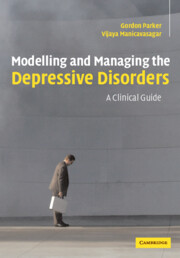Book contents
- Frontmatter
- Contents
- Acknowledgements
- Introduction
- Part I The current model for depressive disorders and its impact on clinical management
- Part II The diagnosis and management of melancholic and psychotic depression
- 4 Management of melancholic depression
- 5 Management of psychotic depression
- 6 Bipolar melancholic or psychotic depression
- Part III An introduction to non-melancholic depression
- Part IV Modelling and managing the non-melancholic depressive disorders
- Appendix 1 The DMI-18 and the DMI-10
- Appendix 2 The CORE system of measuring psychomotor disturbance
- Appendix 3 The temperament and personality measure
- References
- Index
5 - Management of psychotic depression
from Part II - The diagnosis and management of melancholic and psychotic depression
Published online by Cambridge University Press: 17 August 2009
- Frontmatter
- Contents
- Acknowledgements
- Introduction
- Part I The current model for depressive disorders and its impact on clinical management
- Part II The diagnosis and management of melancholic and psychotic depression
- 4 Management of melancholic depression
- 5 Management of psychotic depression
- 6 Bipolar melancholic or psychotic depression
- Part III An introduction to non-melancholic depression
- Part IV Modelling and managing the non-melancholic depressive disorders
- Appendix 1 The DMI-18 and the DMI-10
- Appendix 2 The CORE system of measuring psychomotor disturbance
- Appendix 3 The temperament and personality measure
- References
- Index
Summary
Classification
The nosological status of psychotic depression is unclear. If its definition is determined by a unique specifier (i.e. psychotic features) this argues for a categorical sub-type. In the past, however, such a diagnosis tended to be applied, particularly in the UK, to patients with ‘severe’ depressive conditions, and did not necessarily require psychotic features. Similarly, in the USA, Minter and Mandel (1979) suggested that psychotic depression had ‘Come to mean the same as “endogenous depression” or to mean a severe depression, usually with endogenous symptomatology, not necessarily with symptoms of psychosis’. Viewing ‘psychotic depression’ as synonymous with ‘melancholia’ suggests, in essence, that both were viewed as ‘more severe’ expressions of depression and that the presence or absence of psychotic features was not seen as being of great clinical relevance. We suggest that, phenomenologically, most of the clinical features observed in psychotic depression are ones observed in those with melancholia (albeit generally more severe), apart from psychotic features, and this could argue for the condition being a sub-set of a broader melancholic class. However, in addition, and as noted shortly, psychotic depression is distinctly less likely than melancholia to respond to an antidepressant alone. This characteristic, together with the class specifier (psychotic symptoms) provides the argument for class status.
Clinical diagnosis
Psychotic features are mandatory for the diagnosis (see Fig. 5.1) but, as many patients with the condition have profound psychomotor disturbance (PMD) (sometimes to the extent of being mute and catatonic), the presence of such features may not be volunteered or readily identified.
- Type
- Chapter
- Information
- Modelling and Managing the Depressive DisordersA Clinical Guide, pp. 42 - 46Publisher: Cambridge University PressPrint publication year: 2005
- 1
- Cited by



